One-Year Seismic Survey of the Tectonic CO2-Rich Site of Mefite d’Ansanto (Southern Italy): Preliminary Insights in the Seismic Noise Wavefield
Abstract
:1. Introduction
2. Materials and Methods
2.1. Preliminary Test and Broadband Station Installation
2.2. Seismic Array: Design and Exploration
3. Results
3.1. MEFA Spectral Analysis and Root Mean Square Temporal Pattern
3.2. Array Data Analysis
- (1)
- The main spectral content is distributed in the four bands of Table 3 as identified in the previous analyses;
- (2)
- The spectral content pattern is stable in time;
- (3)
- In general, the spectra of the horizontal components are more complex than the vertical ones;
- (4)
- Stations closer to the Gray Lake (Figure 2) show a significantly higher spectral amplitude above 5 Hz.
4. Discussion
5. Conclusions
Author Contributions
Funding
Institutional Review Board Statement
Informed Consent Statement
Data Availability Statement
Acknowledgments
Conflicts of Interest
Appendix A
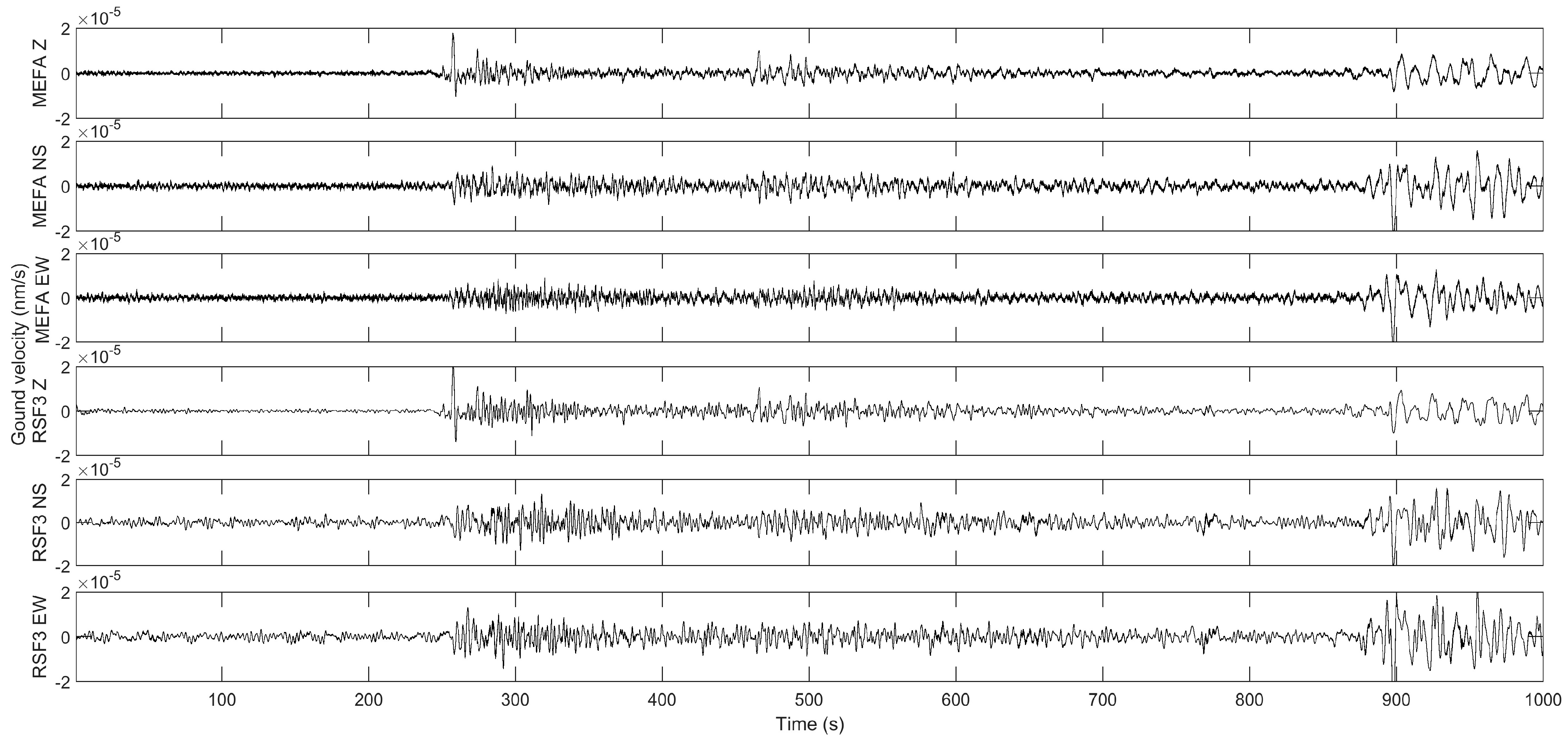
| Name | Latitude (°) | Longitude (°) | Elevation a.s.l. (m) | Sensor Datalogger | Sps (Hz) |
|---|---|---|---|---|---|
| RFS3 | 40.69 | 15.18 | 865 | Agecodagis Osiris6 Nanometrics Trillium-40s | 125 |
References
- Sisto, M.; Di Lisio, A.; Russo, F. The Mefite in the Ansanto Valley (Southern Italy): Geoarchaeosite to Promote the Geotourism and Geoconservation of the Irpinian Cultural Landscape. Geoheritage 2020, 12, 29. [Google Scholar] [CrossRef]
- Mörner, N.-A.; Etiope, G. Carbon degassing from the lithosphere. Glob. Planet. Change 2002, 33, 185–203. [Google Scholar] [CrossRef]
- Chiodini, G.; Granieri, D.; Avino, R.; Caliro, S.; Costa, A.; Minopoli, C.; Vilardo, G. Non-volcanic CO2 Earth degassing: Case of Mefite d’Ansanto (southern Apennines), Italy. Geophys. Res. Lett. 2010, 37, L11303. [Google Scholar] [CrossRef]
- Roberts, J.J.; Wilkinson, M.; Naylor, M.; Shipton, Z.K.; Wood, R.A.; Haszeldine, R.S. Natural CO2 sites in Italy show the importance of overburden geopressure, fractures and faults for CO2 storage performance and risk management. Geol. Soc. Lond. 2017, 458, 181–211. [Google Scholar] [CrossRef]
- Giustini, F.; Brilli, M. Mefite d’Ansanto, southern Apennines (Italy): The natural CO2 seep which emits the largest quantity of non volcanic CO2 on Earth. Int. J. Earth Sci. 2020, 109, 1705–1706. [Google Scholar] [CrossRef]
- Ascione, A.; Ciotoli, G.; Bigi, S.; Buscher, J.; Mazzoli, S.; Ruggiero, L.; Sciarra, A.; Tartarello, M.C.; Valente, E. Assessing mantle versus crustal sources for non-volcanic degassing along fault zones in the actively extending southern Apennines mountain belt (Italy). Geol. Soc. Am. Bull. 2018, 130, 1697–1722. [Google Scholar] [CrossRef]
- Pischiutta, M.; Anselmi, M.; Cianfarra, P.; Rovelli, A.; Salvini, F. Directional site effects in a non-volcanic gas emission area (Mefite d’Ansanto, southern Italy): Evidence of a local transfer fault transversal to large NW–SE extensional faults? Phys. Chem. Earth 2013, 63, 116–123. [Google Scholar] [CrossRef]
- Amoroso, O.; Russo, G.; De Landro, G.; Zollo, A.; Garambois, S.; Mazzoli, S.; Parente, M.; Virieux, J. From velocity and attenuation tomography to rock physical modeling: Inferences on fluid-driven earthquake processes at the Irpinia fault system in southern Italy. Geophys. Res. Lett. 2017, 44, 6752–6760. [Google Scholar] [CrossRef]
- Di Luccio, F.; Palano, M.; Chiodini, G.; Cucci, L.; Piromallo, C.; Sparacino, F.; Ventura, G.; Improta, L.; Cardellini, C.; Persaud, P.; et al. Geodynamics, geophysical and geochemical observations, and the role of CO2 degassing in the Apennines. Earth Sci. Rev. 2022, 234, 104236. [Google Scholar] [CrossRef]
- Cinque, A.; Patacca, E.; Scandone, P.; Tozzi, M. Quaternary kinematic evolution of the southern Apennines: Relationships between surface geological features and deep lithospheric structures. Ann. Geophys. 1993, 36, 249–260. [Google Scholar] [CrossRef]
- Hippolyte, J.C.; Angelier, J.; Roure, F. A major geodynamic change revealed by quaternary stress pattern in the southern Apennines (Italy). Tectonophysics 1994, 230, 199–210. [Google Scholar] [CrossRef]
- Matano, F.; Di Nocera, S. Geologia del settore centrale dell’Irpinia (Appennino meridionale): Nuovi dati e interpretazioni. Boll. Soc. Geol. Ital. 2001, 120, 3–14. [Google Scholar]
- ISPRA. Carta Geologica d’Italia Alla Scala 1:50,000 Foglio 450, S. Angelo dei Lombardi. 2016. Available online: www.isprambiente.gov.it/Media/carg/450_SANTANGELOLOMBARDI/Foglio.html (accessed on 21 December 2022).
- Mostardini, F.; Merlini, S. Appennino centro meridionale: Sezioni geologiche e proposta di modello strutturale. Mem. Soc. Geol. Ital. 1986, 35, 177–202. [Google Scholar]
- Improta, L.; Bonagura, M.; Capuano, P.; Iannaccone, G. An integrated geophysical investigation of the upper crust in the epicentral area of the 1980, MS = 6.9, Irpinia earthquake (Southern Italy). Tectonophysics 2003, 361, 139–169. [Google Scholar] [CrossRef]
- ViDEPI. Progetto ViDEPI-Visibilità dei Dati Afferenti All’Attività di Esplorazione Petrolifera in Italia. 2016 (Last Upgrade). Available online: www.videpi.com/videpi/pozzi/pozzi.asp (accessed on 21 December 2022).
- Cusano, P.; Petrosino, S.; Saccorotti, G. Hydrothermal origin for sustained Long-Period (LP) activity at Campi Flegrei Volcanic Complex, Italy. J. Volcanol. Geotherm. Res. 2008, 177, 1035–1044. [Google Scholar] [CrossRef]
- Chiodini, G.; Cardellini, C.; Di Luccio, F.; Selva, J.; Frondini, F.; Caliro, S.; Rosiello, A.; Beddini, G.; Ventura, G. Correlation between tectonic CO2 Earth degassing and seismicity is revealed by a 10-year record in the Apennines, Italy. Sci. Adv. 2020, 6, eabc2938. [Google Scholar] [CrossRef] [PubMed]
- Yamada, T.; Kurokawa, A.K.; Terada, A.; Kanda, W.; Ueda, H.; Aoyama, H.; Ohkura, T.; Ogawa, Y.; Tanada, T. Locating hydrothermal fluid injection of the 2018 phreatic eruption at Kusatsu-Shirane volcano with volcanic tremor amplitude. Earth Planets Space 2021, 73, 14. [Google Scholar] [CrossRef]
- Nurhasan, Y.O.; Ujihara, N.; Bulent Tank, S.; Honkura, Y.; Onizawa, S.; Mori, T.; Makino, M. Two electrical conductors beneath Kusatsu-Shirane volcano, Japan, imaged by audiomagnetotellurics, and their implications for the hydrothermal system. Earth Planets Space 2006, 58, 1053–1059. [Google Scholar] [CrossRef]
- Panebianco, S.; Satriano, C.; Stabile, T.A.; Picozzi, M.; Strollo, A. Automated detection and machine learning-based classification of seismic tremors associated with non-volcanic gas emission. In Book of Abstracts, Virtual 37th General Assembly of European Seismological Commission 2021; ESC2021-S01-403; European Seismological Commission: Athens, Greece, 2021. [Google Scholar]
- Cusano, P.; Del Gaudio, P.; Galluzzo, D.; Gaudiosi, G.; Gervasi, A.; La Rocca, M.; Martino, C.; Milano, G.; Nardone, L.; Petrosino, S.; et al. Analysis of background seismicity recorded at Mefite d’Ansato CO2 emission field in the framework of FURTHER project: First results. In EGU General Assembly Conference Abstracts 2021; European Geoscience Union: Vienna, Austria, 2021; p. EGU21-10625. [Google Scholar] [CrossRef]
- La Rocca, M.; Galluzzo, D. Detection of volcanic earthquakes and tremor in Campi Flegrei. Boll. Geofis. Teor. Appl. 2017, 4, 303–312. [Google Scholar] [CrossRef]
- Wu, S.-M.; Ward, K.M.; Farrell, J.; Lin, F.-C.; Karplus, M.; Smith, R.B. Anatomy of Old Faithful from subsurface seismic imaging of the Yellowstone Upper Geyser Basin. Geophys. Res. Lett. 2017, 44, 10, 240-10, 247. [Google Scholar] [CrossRef]
- Nardone, L.; Esposito, R.; Galluzzo, D.; Petrosino, S.; Cusano, P.; La Rocca, M.; Di Vito, M.A.; Bianco, F. Array and spectral ratio techniques applied to seismic noise to investigate the Campi Flegrei (Italy) subsoil structure at different scales. Adv. Geosci. 2020, 52, 75–85. [Google Scholar] [CrossRef]
- Di Luccio, F.; Persaud, P.; Cucci, L.; Esposito, A.; Carniel, R.; Cortés, G.; Galluzzo, D.; Clayton, R.W.; Ventura, G. The Seismicity of Lipari, Aeolian Islands (Italy) From One-Month Recording of the LIPARI Array. Front. Earth Sci. 2021, 9, 678581. [Google Scholar] [CrossRef]
- Capon, J. High-resolution frequency–wavenumber. Proc. IEEE 1969, 57, 1408–1418. [Google Scholar] [CrossRef]
- Schweitzer, J.; Fyen, J.; Mykkeltveit, S.; Gibbons, S.J.; Pirli, M.; Kühn, D.; Kværna, T. Seismic Arrays. In New Manual of Seismological Observatory Practice 2 (NMSOP-2); Bormann, P., Ed.; Deutsches GeoForschungsZentrum GFZ: Potsdam, Germany, 2012; pp. 1–80. [Google Scholar] [CrossRef]
- Neidell, N.S.; Taner, M.T. Semblance and other coherency measures for multichannel data. Geophysics 1971, 36, 467–618. [Google Scholar] [CrossRef]
- Lay, T.; Wallace, T.C. Modern Global Seismology; Elsevier: Amsterdam, The Netherlands, 1995. [Google Scholar]
- Cusano, P.; Petrosino, S.; De Lauro, E.; De Martino, S.; Falanga, M. Characterization of the seismic dynamical state through joint analysis of earthquakes and seismic noise: The example of Ischia Volcanic Island (Italy). Adv. Geosci. 2020, 52, 19–28. [Google Scholar] [CrossRef]
- Saccorotti, G.; Maresca, R.; Del Pezzo, E. Array analysis of seismic noise at Mt. Vesuvius Volcano, Italy. J. Volcanol. Geotherm. Res. 2001, 110, 79–100. [Google Scholar] [CrossRef]
- Falanga, M.; Cusano, P.; De Lauro, E.; Petrosino, S. Picking up the hydrothermal whisper at Ischia Island in the COVID 19 lockdown quiet. Sci. Rep. 2021, 11, 8871. [Google Scholar] [CrossRef] [PubMed]
- Bormann, P.; Wielandt, E. Seismic Signals and Noise. In New Manual of Seismological Observatory Practice 2 (NMSOP2); Bormann, P., Ed.; Deutsches GeoForschungsZentrum GFZ: Potsdam, Germany, 2013; pp. 1–62. [Google Scholar] [CrossRef]
- Vassallo, M.; Festa, G.; Bobbio, A. Seismic Ambient Noise Analysis in Southern Italy. Bull. Seismol. Soc. Am. 2012, 102, 574–586. [Google Scholar] [CrossRef]
- Vittecoq, B.; Fortin, J.; Maury, J.; Violette, S. Earthquakes and extreme rainfall induce long term permeability enhancement of volcanic island hydrogeological systems. Sci. Rep. 2020, 10, 20231. [Google Scholar] [CrossRef]
- Andajani, R.D.; Tsuji, T.; Snieder, R.; Ikeda, T. Spatial and temporal influence of rainfall on crustal pore pressure based on seismic velocity monitoring. Earth Planets Space 2020, 72, 177. [Google Scholar] [CrossRef]
- Petrosino, S.; Ricco, C.; Aquino, I. Modulation of Ground Deformation and Earthquakes by Rainfall at Vesuvius and Campi Flegrei (Italy). Front. Earth Sci. 2021, 9, 758602. [Google Scholar] [CrossRef]
- Di Napoli, R.; Aiuppa, A.; Bellomo, S.; Brusca, L.; D’Alessandro, W.; Gagliano Candela, E.; Longo, M.; Pecoraino, G.; Valenza, M. A model for Ischia hydrothermal system: Evidences from the chemistry of thermal groundwaters. J. Volcanol. Geotherm. Res. 2009, 186, 133–159. [Google Scholar] [CrossRef]
- Matthews, A.J.; Barclay, J.; Johnstone, J.E. The fast response of volcano-seismic activity to intense precipitation: Triggering of primary volcanic activity by rainfall at Soufrière Hills Volcano, Montserrat. J. Volcanol. Geotherm. Res. 2009, 184, 405–415. [Google Scholar] [CrossRef]
- Petrosino, S.; Cusano, P.; Madonia, P. Tidal and hydrological periodicities of seismicity reveal new risk scenarios at Campi Flegrei caldera. Sci. Rep. 2018, 8, 13808. [Google Scholar] [CrossRef] [PubMed]
- Montalbetti, J.F.; Kanasewich, E.R. Enhancement of teleseismic body phases with a polarization filter. Geophys. J. Int. 1970, 21, 119–129. [Google Scholar] [CrossRef]
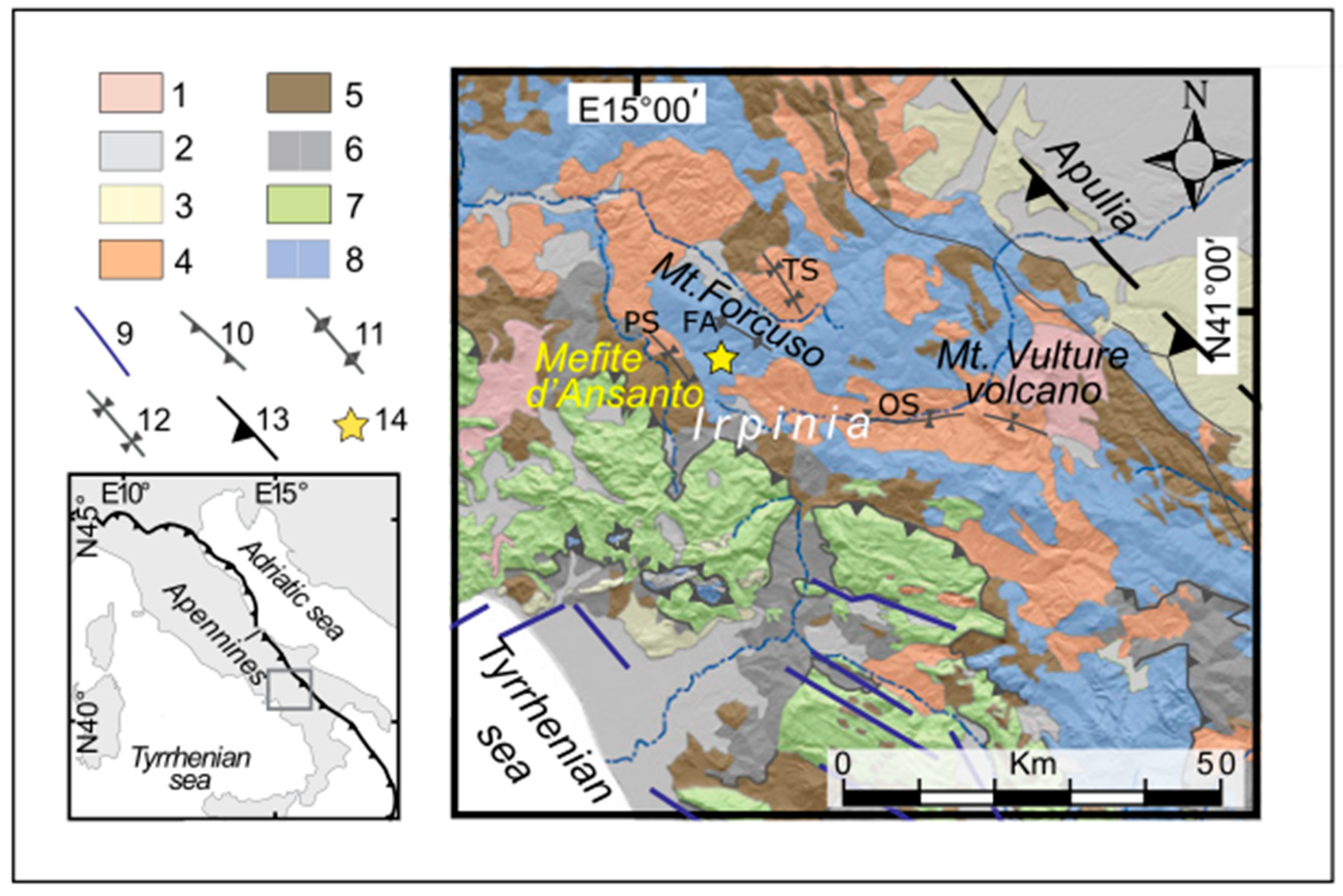
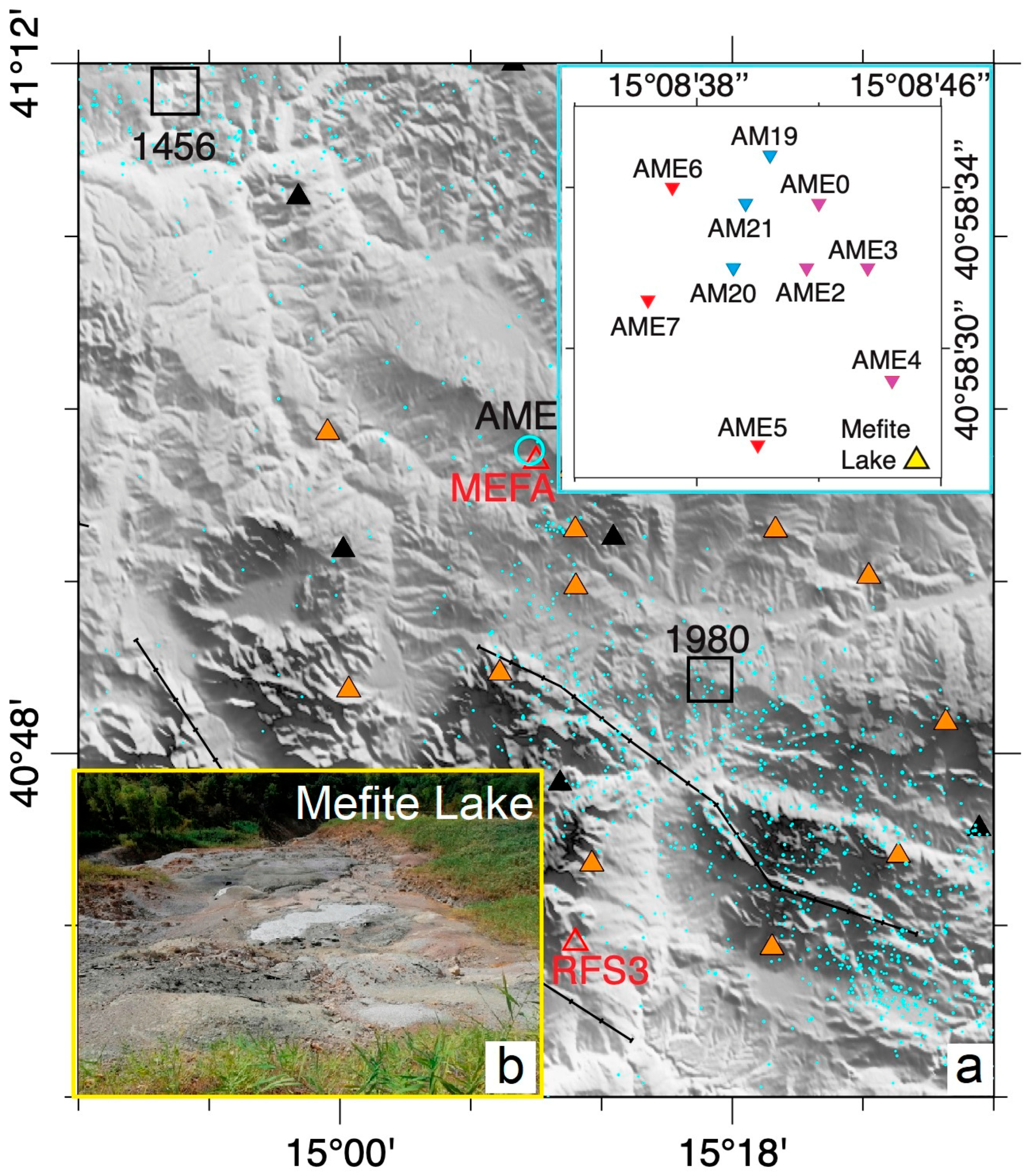
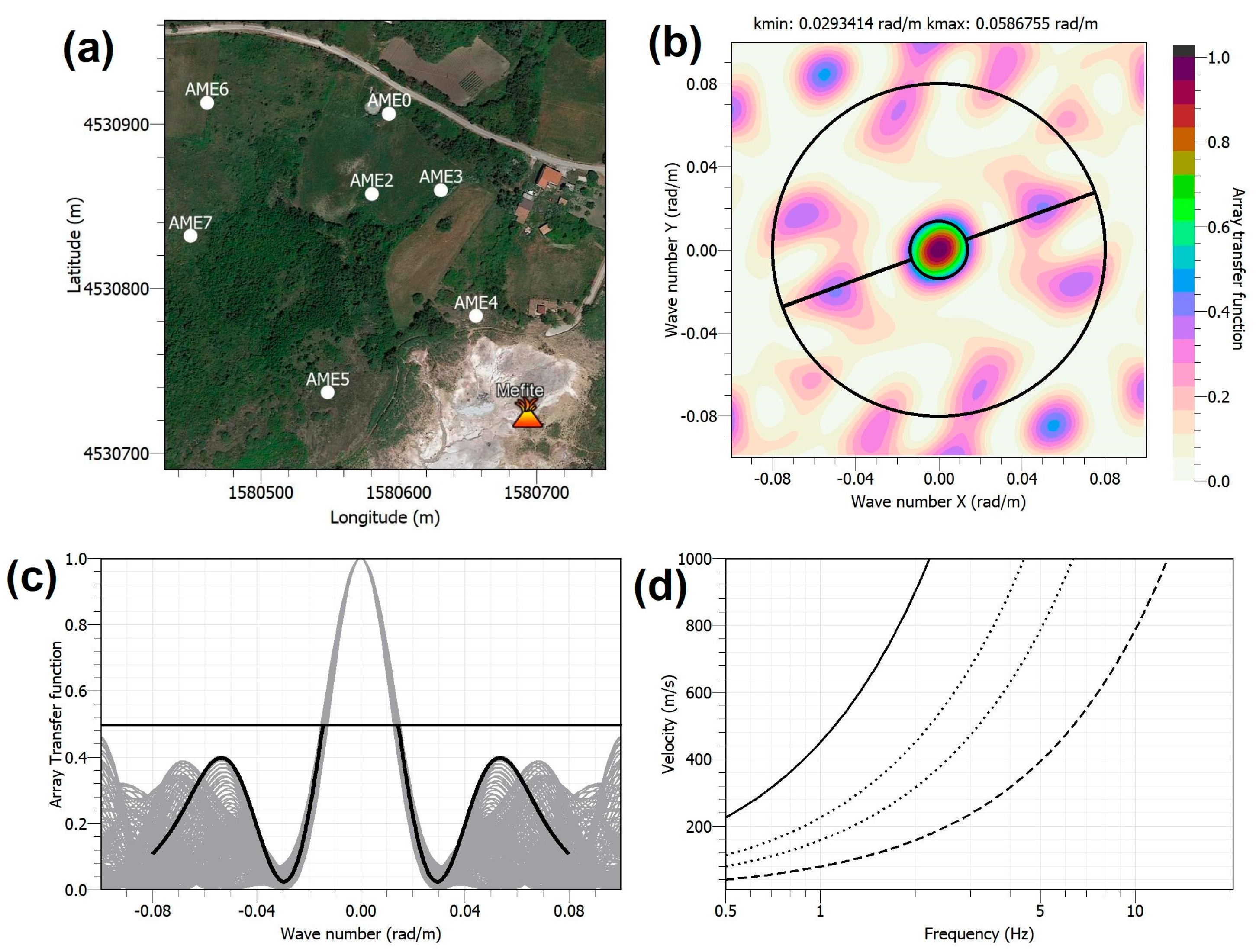


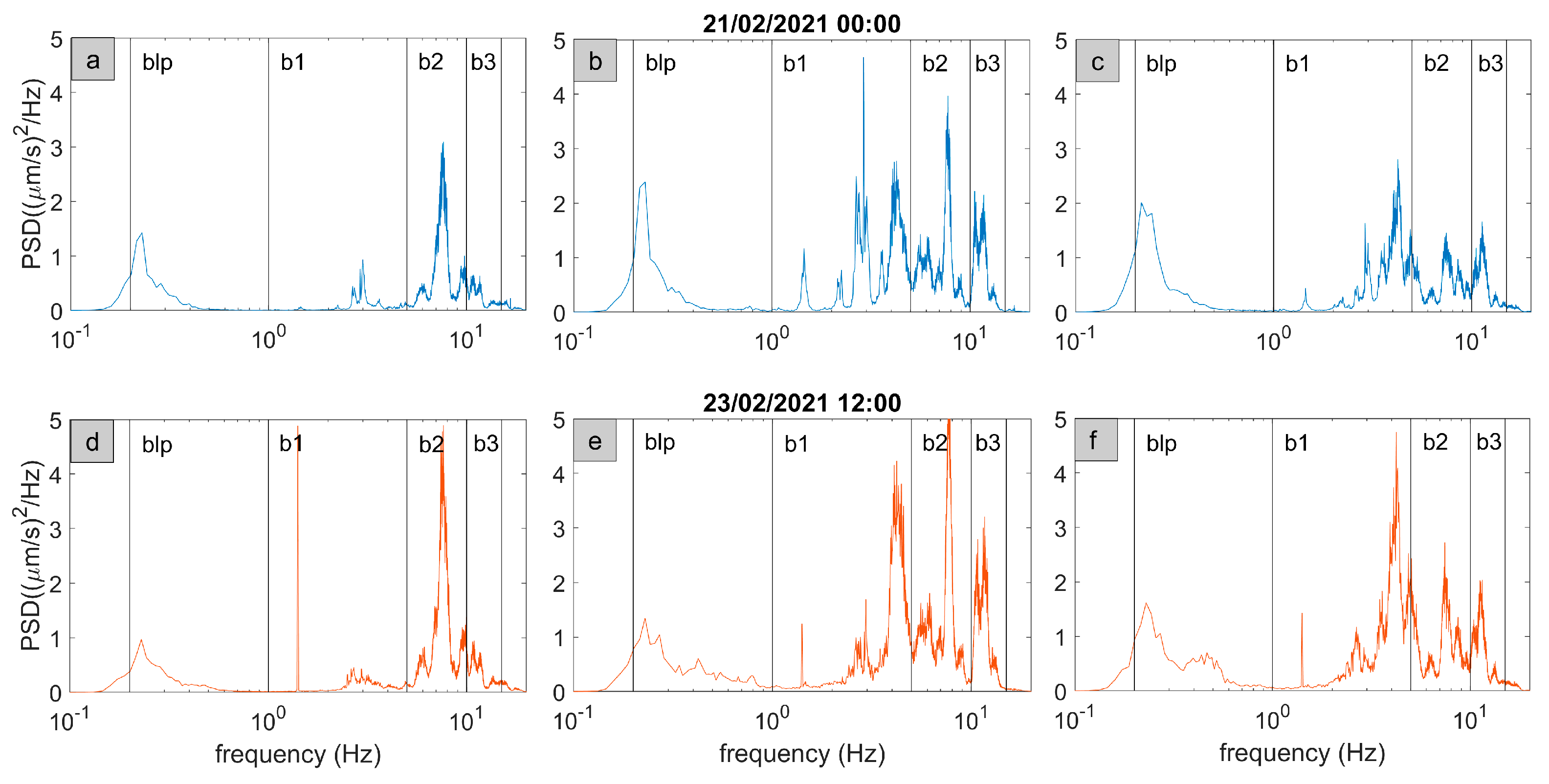

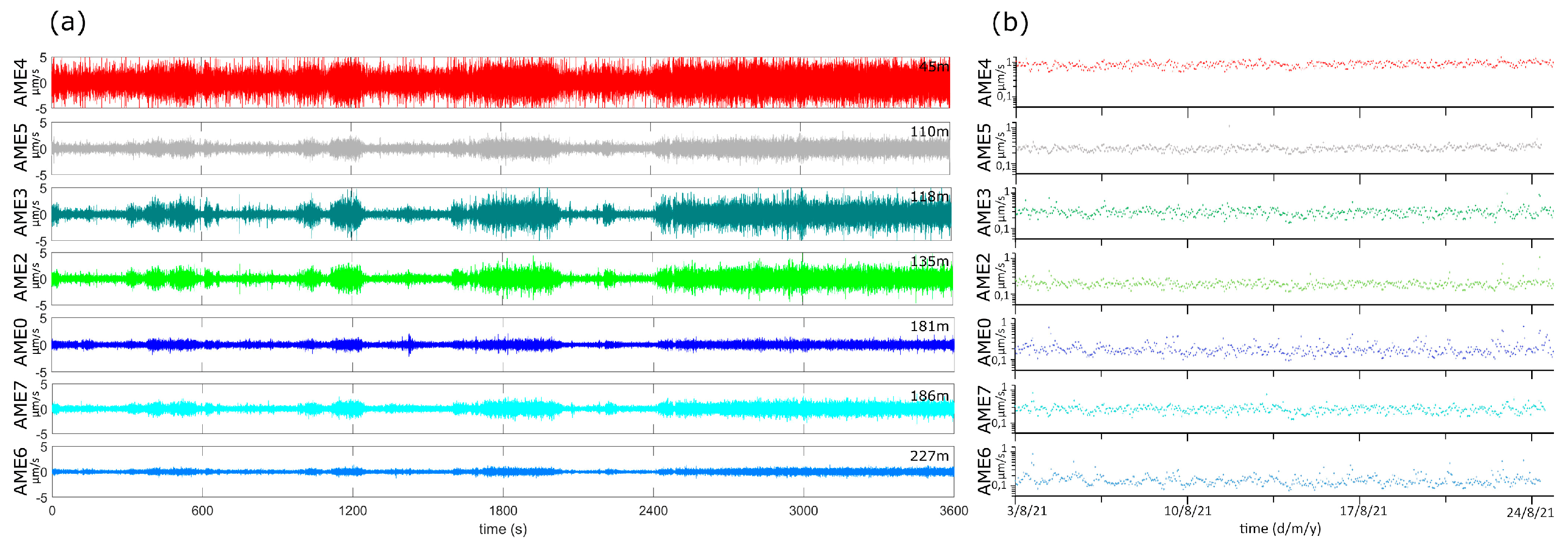
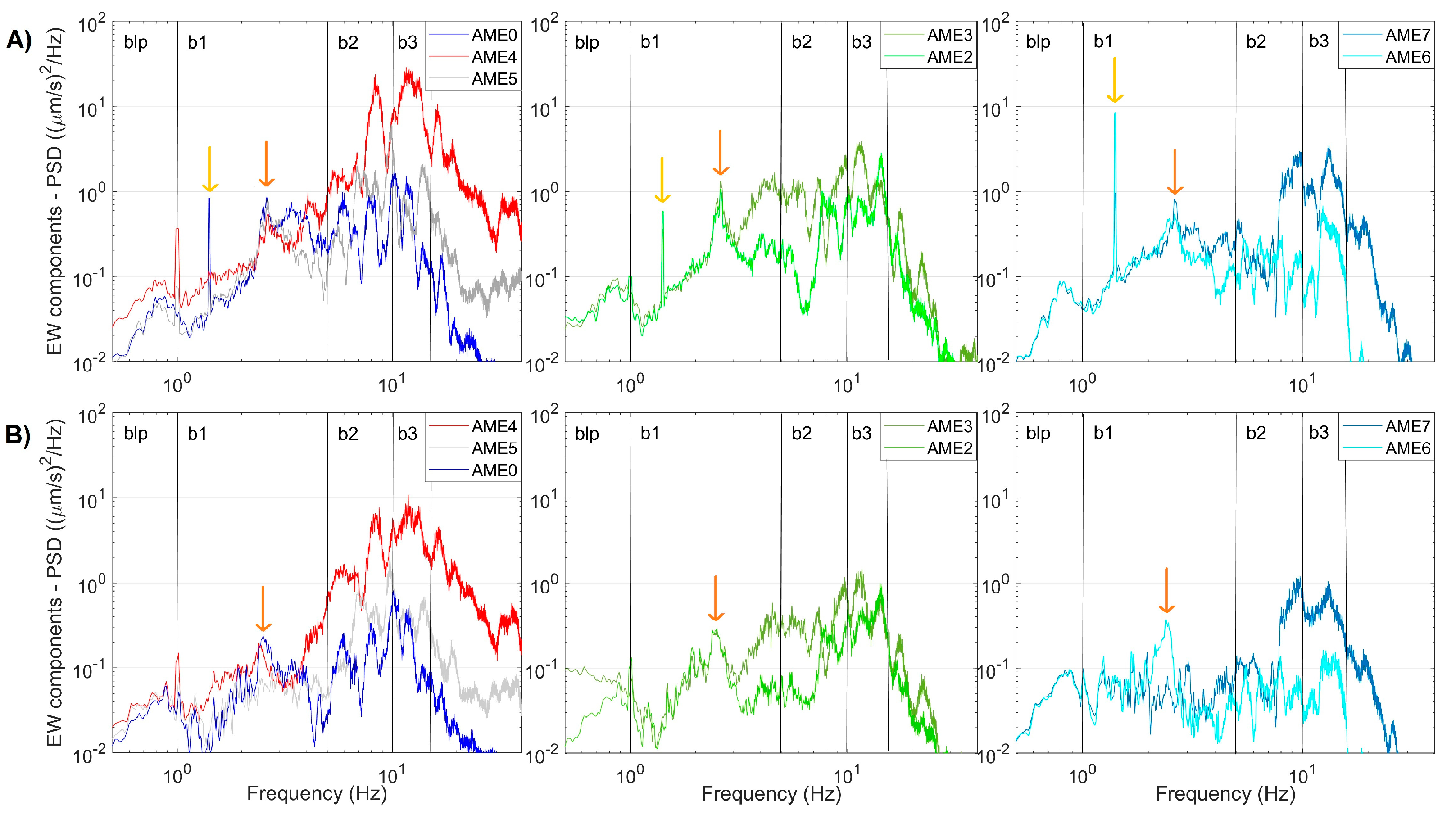

| Name | Latitude (°) | Longitude (°) | Elevation a.s.l. (m) | Sensor Datalogger | Sps (Hz) |
|---|---|---|---|---|---|
| MEFA | 40.98 | 15.15 | 710 | Guralp CMG40T-60s Lunitek Atlas | 100 |
| Name | Latitude (°) | Longitude (°) | Elevation a.s.l. (m) | Sensor Datalogger | Sps (Hz) | Start | End |
|---|---|---|---|---|---|---|---|
AME0 | 40.9759 | 15.1450 | 687 | Lennartz 3D-Lite 1 Hz Reftek | 100 | 8 Jun | 28 Sep |
AME2 | 40.9755 | 15.1449 | 687 | Lennartz 3D-Lite 1 Hz Reftek | 100 | 8 Jun | 28 Sep |
AME3 | 40.9755 | 15.1454 | 694 | Lennartz 3D-Lite 1 Hz Reftek | 100 | 8 Jun | 28 Sep |
AME4 | 40.9748 | 15.1456 | 683 | Lennartz 3D-Lite 1 Hz Reftek | 100 | 8 Jun | 28 Sep |
AME5 | 40.9744 | 15.1445 | 666 | Lennartz 3D-Lite 1 Hz Trident–Nanometrics Taurus | 100 | 8 Jun | 24 Aug |
AME6 | 40.9760 | 15.1438 | 684 | Lennartz 3D-Lite 1 Hz Nanometrics Taurus | 100 | 8 Jun | 24 Aug |
AME7 | 40.9753 | 15.1436 | 683 | Lennartz 3D-Lite 1 Hz Trident–Nanometrics Taurus | 100 | 8 Jun | 24 Aug |
AM19 | 40.9762 | 15.1446 | 692 | Lennartz 3D-Lite 1 Hz Nanometrics Taurus | 100 | 24 Aug | 28 Sep |
AM20 | 40.9755 | 15.1443 | 686 | Lennartz 3D-Lite 1 Hz Trident–Nanometrics Taurus | 100 | 24 Aug | 28 Sep |
AM21 | 40.9759 | 15.1444 | 690 | Lennartz 3D-Lite 1 Hz Nanometrics Taurus | 100 | 24 Aug | 28 Sep |
| Band | Frequencies (Hz) |
|---|---|
| blp | 0.2–1 |
| b1 | 1–5 |
| b2 | 5–10 |
| b3 | 10–15 |
Disclaimer/Publisher’s Note: The statements, opinions and data contained in all publications are solely those of the individual author(s) and contributor(s) and not of MDPI and/or the editor(s). MDPI and/or the editor(s) disclaim responsibility for any injury to people or property resulting from any ideas, methods, instructions or products referred to in the content. |
© 2023 by the authors. Licensee MDPI, Basel, Switzerland. This article is an open access article distributed under the terms and conditions of the Creative Commons Attribution (CC BY) license (https://creativecommons.org/licenses/by/4.0/).
Share and Cite
Morabito, S.; Cusano, P.; Galluzzo, D.; Gaudiosi, G.; Nardone, L.; Del Gaudio, P.; Gervasi, A.; La Rocca, M.; Milano, G.; Petrosino, S.; et al. One-Year Seismic Survey of the Tectonic CO2-Rich Site of Mefite d’Ansanto (Southern Italy): Preliminary Insights in the Seismic Noise Wavefield. Sensors 2023, 23, 1630. https://doi.org/10.3390/s23031630
Morabito S, Cusano P, Galluzzo D, Gaudiosi G, Nardone L, Del Gaudio P, Gervasi A, La Rocca M, Milano G, Petrosino S, et al. One-Year Seismic Survey of the Tectonic CO2-Rich Site of Mefite d’Ansanto (Southern Italy): Preliminary Insights in the Seismic Noise Wavefield. Sensors. 2023; 23(3):1630. https://doi.org/10.3390/s23031630
Chicago/Turabian StyleMorabito, Simona, Paola Cusano, Danilo Galluzzo, Guido Gaudiosi, Lucia Nardone, Pierdomenico Del Gaudio, Anna Gervasi, Mario La Rocca, Girolamo Milano, Simona Petrosino, and et al. 2023. "One-Year Seismic Survey of the Tectonic CO2-Rich Site of Mefite d’Ansanto (Southern Italy): Preliminary Insights in the Seismic Noise Wavefield" Sensors 23, no. 3: 1630. https://doi.org/10.3390/s23031630







